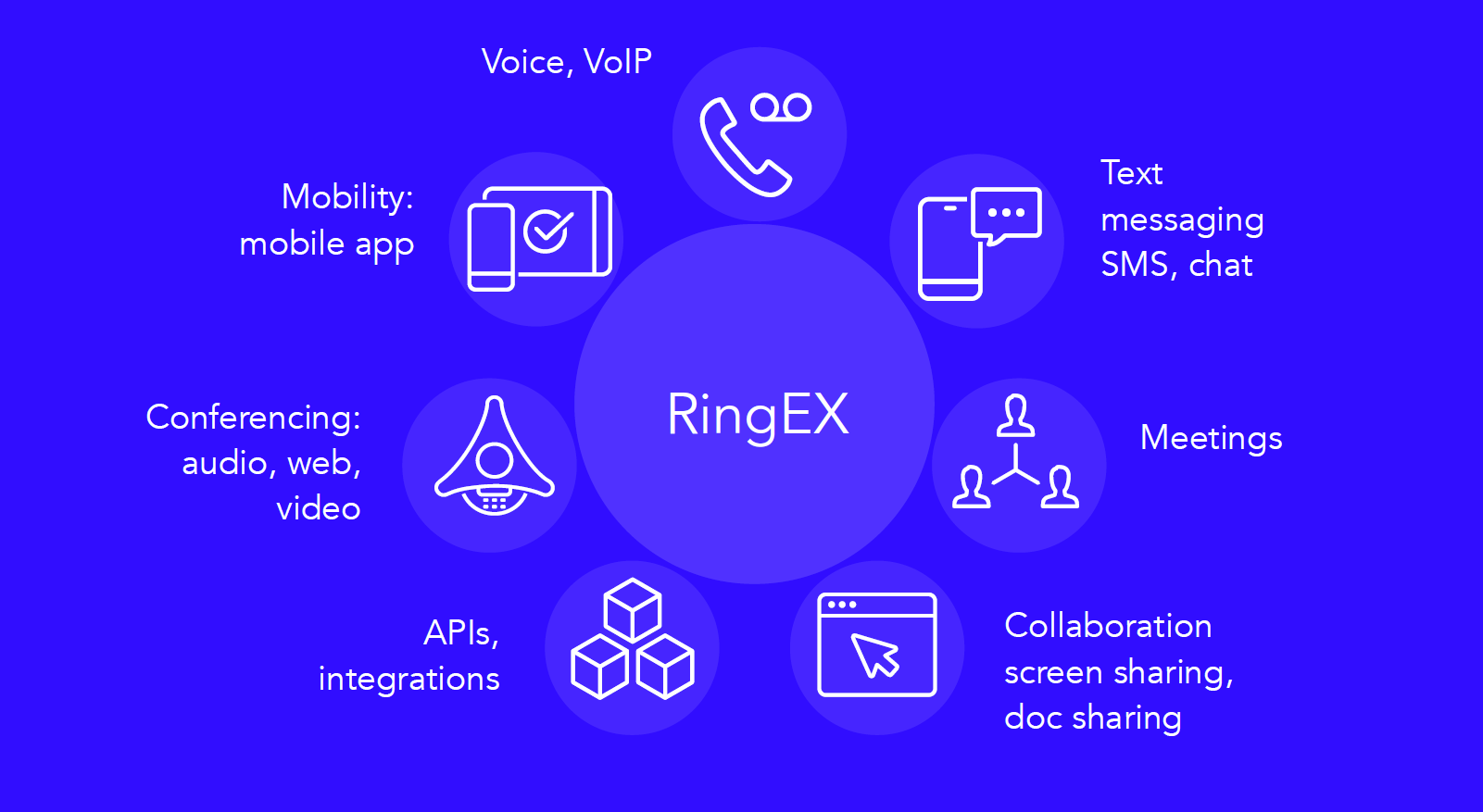

THE CHOICE TODAY IS CLEAR: WHEN IT COMES TO BUSINESS PHONE SYSTEMS AND COMMUNICATIONS SOLUTIONS, THE DIRECTION FORWARD IS THE CLOUD.
Organisations of all sizes and across all verticals are choosing cloud-based unified communications – also known as unified communications as a service or UCaaS – for bringing together voice, text, messaging, video, conferencing, meetings, and more. With UCaaS, workers can seamlessly communicate over voice, instant messaging, and video from any device and location, improving worker productivity and effectiveness.
The market for cloud-based business telephony services is growing quickly. According to MZA’s 2018 “Global Cloud/Hosted Business Telephony” analysis, end-user revenue is expected to grow to £10.4 billion by 2023, with the installed base of users almost doubling between 2018 and 2023.1
Gartner
The drawbacks of on-premises communications systems continue to create considerable challenges for today’s modern workers. A more distributed and mobile workforce demands flexible solutions for communicating and collaborating across locations and time zones. As a result, in the past few years, cloud-based communications and collaboration services have seen tremendous growth as companies recognise their many benefits, including reduced complexity, lower operational overhead, and minimal IT requirements.
In many ways, the tide has turned. Cloud solutions have overtaken premises-based solutions as organisations look to replace outdated legacy PBXs. According to Gartner, by 2024, 74% of UC licenses will be cloud-based, an increase
The shift to the cloud becomes even more clear when you look at where investments are being made, as today’s innovations are taking place in the cloud. From artificial intelligence to advanced mobility and video
capabilities, essentially all vendor investments are directed at cloud solutions. In fact, new solutions, such as team collaboration, are entirely cloud-based, with no on-premises options being developed. Speed to
innovation takes place much faster in the cloud since open cloud-based platforms make it easier to add new capabilities, from persistent chat to video conferencing to omnichannel contact centre, enabling organisations to digitally transform.
In addition, competitive pressures and the need to “disrupt or be disrupted” are driving the push to UCaaS solutions. Businesses need to be nimble and flexible while accessing the latest technologies and innovations—however, this is only possible with cloud solutions such as UCaaS.

Simplicity
Deployment, management, and maintenance of communications solutions are greatly simplified, saving time and money while enabling your IT staff to focus on other things that may be closer to your core business. Without the need for servers or ongoing maintenance and upgrades, cloud services are generally much simpler to deploy and manage, with built-in scalability, redundancy, security, and disaster recovery.
Cost and scalability
The cloud’s pay-as-you-go model means you only pay for the communication services and licenses you need, providing an immediate return. Businesses can be more flexible and easily add users as needed. This is especially important for seasonal businesses, such as florists or tax accountants, that have high-volume communication needs at certain times of the year. With
little or no capital expenditures, organisations pay only for what they need and can scale up or down to best meet their needs.
Reduced risk
Companies can be guaranteed to get the latest and greatest communication features as they’re introduced while automatically staying current with new releases, reducing the risk of technology obsolescence and sunk costs. As new capabilities and functionality are added, such as AI, enhanced video, or mobility, organisations can access them straight away.
Global reach
Workers, regardless of geographical location, can be on the same platform, enhancing communications and collaboration throughout the organisation.
Based on capabilities such as mobility, conferencing, web collaboration, single-number reach, and others, UCaaS allows workers to work from any location and remain productive. In addition, cloud providers offer off-site backup, redundancy and disaster recovery, which is too expensive or hard to do on-premises.
Mobility
With no software to download to the desktop, workers just need an internet connection and headset, and they’re good to go! On-the-go workers can receive calls, send and receive IMs, and have web and video
conferences from anywhere.
Advanced capabilities
Organisations can access advanced features and capabilities, such as video conferencing, that may otherwise be cost-prohibitive with a premises-based solution.
Integration with third-party applications
Open cloud platforms allow companies to connect communications to a wider set of business applications by leveraging APIs and integrations. These include integrating with CRM, ERP, productivity applications (such as Google G Suite and Microsoft Office 365), and other third-party applications. It also includes integrating best-of-breed capabilities, including messaging, video, and analytics.
Flexibility
Perhaps the biggest benefit of a cloud-based service is its flexibility, which makes organisations more nimble and agile. When it comes to flexibility, premises-based solutions don’t hold a candle to cloud-based services, which make it easy to add new functionality in minutes. Changing at a rapid pace, much of today’s on-premises communications technologies will be outdated or even obsolete within the next two to three years. As new services and functionality are developed, whether they are artificial intelligence or enhanced mobile or video capabilities, cloud users can access these capabilities immediately without having to deploy new servers or software.
Unified communications are more than its parts or components – it’s about bringing the various functions together, including voice/telephony, conferencing, messaging, collaboration, video, and more on a unified platform to provide a holistic experience. RingCentral Message Video Phone (RingEX) does just that.
Today’s workers are more collaborative, requiring tools that make it easy to share information. A complete UCaaS solution should go beyond telephony, including conferencing and collaboration capabilities, such as messaging, document sharing, and screen sharing. It should also include web, audio, and video conferencing while enabling workers to connect from any device and any location to access data, applications, and other critical business tools in one place. Going the next step,
UCaaS solutions provide mobile workers with the communication applications that fit their mobile work styles by seamlessly integrating multiple locations and connecting mobile workers with advanced call forwarding, single number reach, desktop extension, and mobile clients.
With an open platform that integrates UCaaS and brings various cloud services together, including contact centre and team collaboration, organisations can enhance internal and external communications and collaboration, increase efficiency and effectiveness, and better serve customers.

Nothing lasts forever, including PBXs. Technology changes quickly, and legacy PBXs are no longer up to the task of today’s workplace. Lifecycles for PBXs have gone from 10 to 15 years, to 7 to 10 years, and then down to four years or less. With resources being focused on newer cloud solutions, many vendors are end of life-ing older legacy PBXs at a rapid pace. When a PBX system is no longer supported by the vendor, it becomes challenging to get the proper service, replacement parts, and expertise needed. Challenges such as fewer trained resources to support legacy equipment make maintaining aging PBXs even more
If your PBX system is being end-of-lifed and no longer supported by the vendor, it’s time to look at new options that meet today’s business needs while taking advantage of new UC capabilities that may have been previously out of reach. Rather than simply replacing an old phone system with a new phone system, use this transition to provide enhanced unified communications capabilities, including messaging and meetings, that make your workers more productive and effective.
Hopefully by now you’re convinced that UCaaS is the way forward, but what’s the best cloud approach and migration strategy?
First, it’s important to understand that there are various cloud options. Is it private or public? Are there multiple instances? Does it accommodate multiple tenants? Is it a hybrid deployment? Depending on the configuration, here are some key considerations:
- Multi-tenant or “pure cloud”: Multi-tenant cloud services, considered “pure cloud,” are the fastest-growing architecture. As the most economical option, a multi-tenant architecture takes advantage of the true benefits of the cloud, including economies of scale, fast deployment, business continuity and redundancy, automatic updates, and more. Most experts agree that a “true” cloud is a multi-tenant, shared, on-demand platform providing scalability and elasticity based on a shared pool of resources that are rapidly provisioned with minimal IT requirements. Organisations benefit by leveraging shared resources, capacity, and costs within the service provider’s data centre.
- Multi-instance cloud: With a hosted or multi-instance architecture, each user has its own virtualised software instance on shared hardware. This option may be able
- Private cloud: Private-cloud services leverage virtualised software in the company’s own data centre, which means they can provide a higher level of customisation. This is the most expensive option and doesn’t provide economies of scale, flexibility, and other cloud benefits. Private cloud is generally seen as an option for regulated businesses and businesses requiring the highest levels of security, although this is changing as public cloud services have become more secure and are increasingly used by government agencies and regulated businesses.
- Hybrid cloud: Hybrid cloud services combine elements of on-premises and cloud services, with some core functionality remaining on-premises. This model is often used as a way of transitioning to the cloud from older legacy PBXs, where a segment of workers continue to use the premises-based PBX, while others move to the modern unified communications cloud service. Hybrid systems may also be useful for regulated businesses that require some on-premises equipment in order to meet security requirements or for large organisations with many branch locations that can’t migrate to cloud services all at once.

| Private Cloud | Single-tenant public cloud (multi-instance) | Multi-tenant public cloud | Hybrid cloud |
|---|---|---|---|
| Virtualised software in company’s own data centre. | Company has its own virtualised software instance of app on shared hardware. | All users share a common (single) software instance on common hardware platform. | Mixture of on-premises and cloud-based platforms or apps. |
| Most expensive, longest deployment time, not as scalable, requires significant IT staff. | More expensive than multi-tenant, not as scalable, longer deployment than multi-tenant, may require more professional services. | Most cost-effective, scalable, requires less IT staff than other options, easiest to deploy globally | Gives up some benefits of the cloud but leverages customers’ existing solutions. |
| Provides high level of reliability, security, customisation, control over operations. | May provide more customisation, security, and privacy. | Least able to customise and integrate with apps and systems. | More expensive to manage than multi-tenant. |
As you prepare to migrate to the cloud from a premises-based PBX, having a migration strategy is essential.
First, define your goals and priorities. The new solution must meet your unique business needs, which requires an understanding of why you’re moving to the cloud. Prioritise what’s most important, whether it’s flexibility, scalability, cost management, advanced functionality, etc. From there, it’s easier to identify the right solution and potential providers.
Next, determine the best migration approach based on business priorities and/or strategic locations. There are many options, and working with a professional services organisation can help identify the best approach for your specific needs.
Migrating a group of users, such as the C-suite or IT organisation, is a way to understand the features and functionality of the new service and set the stage for company-wide user adoption. Alternatively, starting with specific locations, such as branch offices or regions, may make sense. Look at when PBX service contracts
Some organisations opt for hybrid cloud solutions as an intermediary approach. While the hybrid-cloud approach lets organisations leverage their existing communications technology while migrating to the cloud, it’s often seen as a stop-gap approach, and there are some challenges that organisations need to consider. Managing hybrid solutions and getting them to work effectively is often difficult, as cloud and premises-based communication platforms have different security and administration models, different call plans that need to be integrated, and different compliance and security methods. With a duplication of costs,
hybrid options generally end up being more expensive. Without feature parity, employees on different systems will have different user experiences, making it more challenging to effectively collaborate.
To attain the scale and cost benefits of the cloud, a coexistence approach that includes migrating to an open platform in the cloud is often the right approach.
The next step in the migration process is to select a vendor and cloud service. Here are some key attributes to look for in a platform vendor:
- Unified platform: Working with a vendor that offers a full solution, including telephony/PBX, unified communications, team collaboration, meetings, and contact centre, makes it easier to get the capabilities you need without having to interact with multiple vendors. Using the same vendor and platform for contact centre, team collaboration, and UC reduces management requirements and provides end-to-end support with no finger-pointing between vendors. In addition, a single vendor has more control over the product, including new feature releases and the ability to keep features current on both platforms.
- Reliable and secure: It goes without saying that reliability, security, and support are crucial, so look for a vendor that can provide high availability and quality of service. For international organisations, working with a company that has global reach with geographically dispersed data centres and support centres is an important consideration.
- Integrations: UCaaS doesn’t exist in isolation, and integrating well with third-party business applications has become a key area of differentiation. APIs are today’s building blocks for integrating a wide range of applications and capabilities that your organisation utilises. Look for a vendor with an open platform that offers out-of-the-box integrations, as well as APIs that will make the UCaaS solution a part of your business’s day-to-day workflows.
- Experience: Choose a vendor that has lots of experience migrating organisations from premises-based PBXs to the cloud. In many cases, a professional services engagement will be necessary, providing industry expertise and experience in network assessment, as well as designing, developing, and architecting the right solution. Don’t take chances with a new player without a long track record or strong financials – look for a provider with the experience needed to help you succeed today and with the vision to prepare you for tomorrow.
RingEX and Daisy offer you a faster, Gartner-endorsed route to powerful, future-proofed communications. In an age of globally-dispersed, ultra-mobile workforces that rely on agile, multi-channel collaboration, traditional PBX telephony is struggling to cut it.
Cumbersome and costly to maintain, these outdated systems are increasingly approaching end-of-life, while innovation and investment flow in one direction only: the cloud.
Fast, cost-effective migration, with near-instant benefits. Compared with upgrading your PBX system, migrating to cloud-based Unified Communications as a Service (UCaaS) is both easy and transformative – especially with Daisy and our partner RingEX – a leader within the UCaaS Gartner Magic Quadrant. We can help your transition from yesterday’s outdated technology to today’s modern innovative solutions – and prepare you for tomorrow’s challenges.